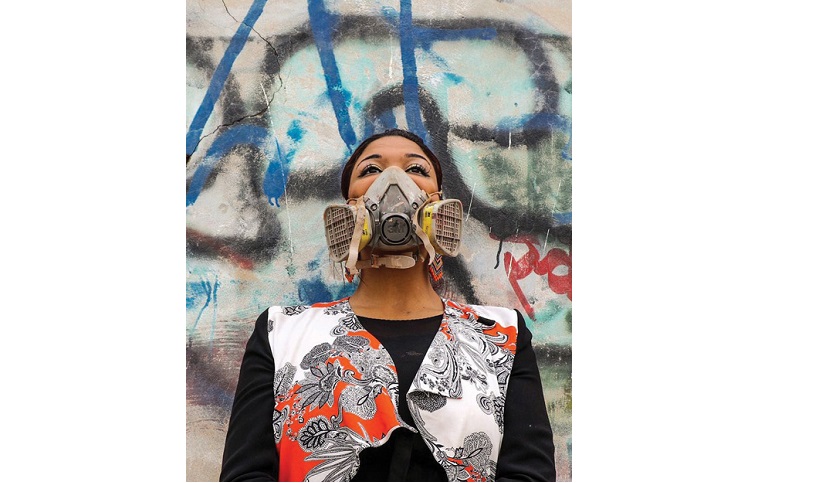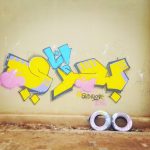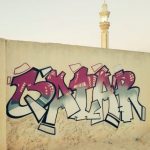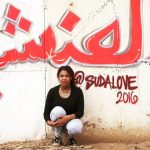Also known as ‘Sudalove,’ Assil Diab is a Sudanese Visual Artist, Graphics Designer and Graffiti Artist born in Romania and based in Doha, Qatar. Her work consists of mixed media and painting canvases using nothing but spray paint, “Graffiti on Canvas,” as well as graffiti murals. She exhibited her artwork at Virginia Commonwealth University in Qatar, local hotels in Qatar, and Gallery 5 in Richmond, Virginia. In 2015, Diab was invited by Red Bull Qatar to attend an opening of ‘Urban Nest,’ their very own Art Space in Bahrain called ‘Malja,’ where she painted an XO graffiti piece on their yard.
Diab also exhibited her “What About Africa” piece, made entirely of spray-painted, recycled water bottles, and the intriguing “Death & The Circle of Life” piece, made entirely of spray-painted worms and cockroaches during the book launch of The Khaleeji Voice.
Commissioned by Urban Creativity – 60 Degrees and Al Jaidah Automotive, Diab’s most notorious graffiti work yet is at the Qatar Racing Club in 2014, which was the major breakthrough in her graffiti career.
When did it all begin? How did you first become interested in street art/graffiti?
When I was about 14, I started doing it on paper and painting on T-shirts, shoes, hats, etc. But I didn’t get into it seriously until I was about 25. When I was about 21, I used to see it everywhere in New York, especially while on the subway. I was attracted to it from the get-go – the shapes and colors. I just admired it. I loved what I was seeing on the streets, and I wanted to be a part of it. I’ve always liked challenging myself to see what I could do. Who would’ve thought I would be a graffiti artist?
Where did the name come from?
“Sudalove” represents my home country, Sudan, and my love for it. I wanted to take Sudan with me everywhere. My identity does not only rely on being a female and Sudanese, but also on bringing what I know from back home and taking it with me wherever I go.
How do you describe the style of your pieces?
Most of my work leans toward typographic design. I think my BFA degree in Graphic Design plays a big role in that. I like to experiment with every piece. Sometimes I tag in Arabic and sometimes in English. I’ve been told that most of my work is recognizable. I think it has something to do with “muscle memory.” Some letters and shapes look repetitive and that somewhat develops a style.
Which artist is your biggest inspiration?
“El Seed.” He’s taught me how to spray paint and gave me the confidence to just “go ahead and start.”
What was your greatest challenge?
The main challenges I face are with myself. Trying to be better than I was the last time, trying to stay inspired and creative. It’s an ugly world out there that I want to help beautify. It takes me a couple of days before I get the urge to go out and paint again.
Can you tell us something about your process? How long does it take from beginning to end to create a painting?
When it comes to non-commissioned work, I study the surroundings of the wall – its texture, color. I basically treat the entire surface as a canvas. I don’t usually sketch, if I have to, it’s because a client has requested it. I then pick up a can and I just let it all out on the wall. When the artwork is complete, I take a step back and look at the result and study how art changes the scenery and the community.
Do you have a formal art education?
I do hold a Bachelors of Fine Arts in Graphic Design from Virginia Commonwealth University in Richmond – Virginia, United States. I also took up a minor in Fashion Design with a special interest in Footwear Design. I also hold two diplomas in Social Media Marketing and Advanced Digital Marketing.
Has your work ever been exhibited?
Yes, my “graffiti on canvas” pieces have been exhibited in Qatar. I also do commissioned work and sell them online on qatarcollections.com and assildiab.com.
How do you feel about the movement of graffiti into galleries?
I feel like what makes graffiti unique is the audience it can reach, which is unlimited. When you take it to canvas and place it in a gallery, you are limiting the audience perhaps to only the art scene and whoever is interested in it. However, bringing graffiti into galleries is always safer than going out in the street.
What do you see as the future of street art / graffiti?
There is a huge rise in the number of graffiti artists coming out. I’m not sure if some are doing it for the fame or to spread love. If graffiti is put to a good cause, it can benefit social development by founding art schools in low-income neighborhoods and by partnering with police to paint murals in neglected and shabby areas. Graffiti can serve as community service, if the artist’s state of mind is at peace with the world.
Originally published on www.kingdome.co. You can follow Kingdome on Facebook and Soundcloud @KingdomeMagazine, Instagram @Kingdome.co, Twitter @KingdomeCo and on YouTube: Kingdome Magazine.














